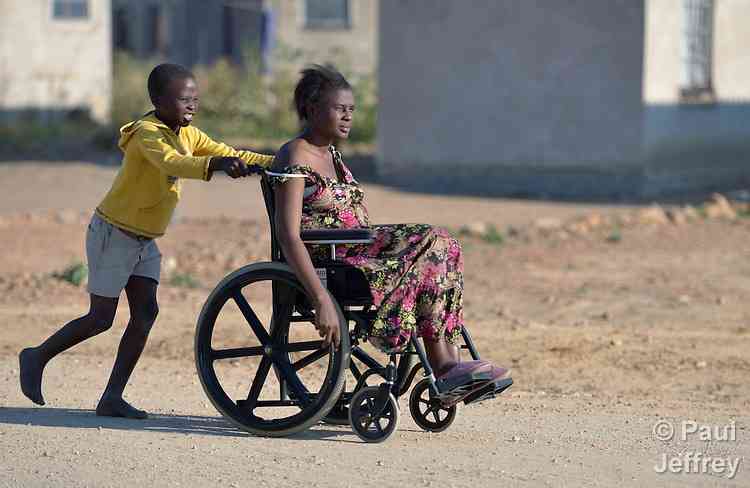
AN assistive device is an enabler, the device assists a person with a disability to perform daily tasks and enhances their mobility and communication.
Assistive devices, include wheelchairs, hearing aids, crutches, white canes, spectacles, low vison devices among others. Assistive devices range from simple devices to high technology, motorised or communication devices.
Physical modifications in the built environment are necessary and this may include ramps, wider entrances, grab rails to enable support and easy access.
Without assistive devices people with disabilities will face challenges in accessing education, employment or participating in society further worsening the disability poverty cycle.
People with disabilities will lack the means to participate in programmes, which enable their independent living therefore assistive devices are a basic need.
People with physical impairments have difficulty in standing or sitting and are at risk of further deformities if they are not supported, increasingly the benefits of assistive devices are recognised for older people. One of the common factors is the unavailability of assistive devices in less resourced settings or remote areas.
While assistive devices are designed to be suitable, some of the devices are not suitable and durable in specific environments. For example, some wheelchairs are not suitable for the rough terrain and yet it is assumed that assistive devices should meet the individual needs and should be acceptable by the user.
When the device becomes dysfunctional is it difficult to get it repaired or replaced. In some cases, the assistive devices have been provided without proper assessment, causing more harm than good to the user or recipient.
Due to limited options and poverty the person with a disability accepts the inappropriate device without recognising the worth for users.
Availability and affordability of assistive devices are a major hindering factor in Zimbabwe, most of the assistive devices are imported and there is very little local production.
This is a major gap contributing to the high cost of assistive devices. A comprehensive assessment is important in ensuring that the assistive device meets the needs of the person with a disability, hence the importance of having trained personnel to conduct such assessments.
Provisions in CRPD
The convention clearly outlines the importance and commitments by state parties as outlined in articles 4, 20 and 26.
Promoting research and development in technology and mobility aids or assistive devices is imperative in ensuring affordable devices for people with disabilities.
Article 20 of the Convention on the Rights of Persons with Disabilities (CRPD) highlights the need to facilitate access to affordable assistive devices. It encourages entities to produce assistive devices that take into account the diverse spectrum of disability, including the dissemination of accessible knowledge.
Article 26 emphasises the need for rehabilitation services in ensuring appropriate provision of assistive devices that do no harm to the person with a disability. This includes the need to train professionals in providing rehabilitation services.
Full equality of opportunities requires enhanced access and without appropriate assistive devices people with disabilities are excluded from society and mainstream development. Women and girls with disabilities are more vulnerable and experience multiple discrimination and very little effort have been made to obtain their views regarding assistive devices. Children with disabilities require devices that will suit them and enable easy mobility.
Provisions in the NDP
The provisions in the National Disability Policy have aligned to the CRPD, an indication of the government’s commitment towards provision of assistive devices for people with disabilities.
It is the responsibility of the government to provide free assistive devices or to regulate the prices and quality of assistive devices to ensure affordability and accessibility to people with disabilities.
Effort must be made to map the suppliers of assistive devices at all levels (provincial, national, continental and international) in order to enhance the supply chain and wide range of distribution channels is recommended to enable access. The local production of assistive devices is encouraged, taking into account different types of impairments. Appropriate provision of assistive devices in line with prescriptions, seating guidelines and assessments is important to ensure we do no harm to the person with a disability.
This involves the provision of services that ensure appropriate fitting, mobility training and maintenance. Generally, the provision of assistive devices is confined to specific geographical areas and yet the needs within the country remain unmet usually in rural or remote areas.
Recommendations
It is important to work with people with disabilities and their families to determine their needs and ensure appropriate provision, support and replacement of assistive devices.
User training, education and follow-up is necessary to allow for appropriate use and care. Barriers affecting access to assistive devices, such as inadequate information, distance and high costs should be mitigated.
In addition, there is need to increase partnerships in the production and supply of a wide range of assistive devices and consider ways of decentralising service provision.
In light of the poverty disability cycle, it is important to identify funding options for people, who are unable to afford the costs associated with provision of assistive devices.
Although resources are limited, the Ministry of Public Service Labour and Social Welfare under the Department of Disability Affairs has prioritised support for assistive devices.
It is believed that an assistive device service is effective when it is provided through a network of channels at various levels of care.
Special attention should be given to conditions, such as cerebral palsy, which require postural support and additional adaptions to maintain a good sitting position.
Some technology is not suitable for the remote areas, therefore, the assistive devices should be carefully designed and selected to meet the user needs taking into account the environmental, social, cultural and economic factors.
Promoting standards is key in addressing quality issues. Adaptions to the physical environment are necessary to achieve maximum function and independence.
Further, it is important to consider other barriers, such as attitude or stigma, which can influence a person’s ability to use the device.
Training is necessary for health personnel to ensure that they are able to assess, prescribe or make provision.
Establishing community-based repair services for people in rural areas will address some of the challenges experienced in maintenance.
The collection of disability disaggregated data defining the needs of people with disabilities is important in informing decisions, provision and evaluating interventions in the provision of assistive devices.
The provision of assistive devices in humanitarian situations should not be overlooked, while people with disabilities lose or get their devices damaged in a crisis affecting their independence and mobility others will acquire an impairment as a result of the crisis.
According to the WHO Global Report on Health and Equity for Persons with Disabilities (2022), the provision of assistive devices is a key facilitator for access to health services by people with disabilities.
Ultimately people with disabilities need assistive devices that are of good quality and enable them to participate in society.
Tigere is a development practitioner and writes in her personal capacity. These weekly New Horizon articles, published in the Zimbabwe Independent, are coordinated by Lovemore Kadenge, an independent consultant, managing consultant of Zawale Consultants (Pvt) Ltd, past president of the Zimbabwe Economics Society and past president of the Chartered Governance & Accountancy Institute in Zimbabwe (CGI Zimbabwe). — kadenge.zes@gmail.com or mobile: +263 772 382 852.






